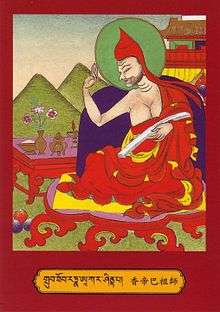Ratnākaraśānti
Ratnākaraśānti (also known as Śāntipa) (c. 1000 CE) was one of the eighty-four Buddhist Mahāsiddhas and the chief debate-master at the monastic university of Vikramashila. At Vikramashila he was instructed by Nāropa,[1] and taught both Atiśa and Maitrīpa.[2] His texts include several influential commentaries to Buddhist tantras, as well as works of philosophy and logic.

Little else is known about his life; in the Biography of the Eighty-Four Siddhas, Abhayadhatta records that "King Kapina" invited Ratnākaraśānti to Śrī Laṇka during the reign of the Pāla king Devapāla (c. 810-850 CE).[3] However, according to Keith Dowman, "As history of Śrī Laṇkā the legend is incomprehensible. There is no King Kapina in the lists of Siṇghala kings… [and] there is no evidence of a Śāntipa contemporary with the Pāla Emperor Devapāla."[4] Tāranātha provides a more realistic date, placing him during the reign of King Canaka (955-83 CE).[5]
Ratnākaraśānti composed three commentaries to the Guhyasamāja Tantra, as well as commentaries to the Hevajra Tantra and the Mahāmāyā Tantra. His exoteric works, generally written from a Yogācāra perspective, include several commentaries to the Perfection of Wisdom literature, such as his Sāratamā and Pith Instructions for the Perfection of Wisdom (Prajñāpāramitābhāvanopadeśa). He is also the author of two commentaries to Śāntarakṣita's Madhyamākalaṃkāra, and a technical treatise on the formal logic of pramāṇa theory (the Antarvyāptisamarthana).
Ratnākaraśānti was a Yogacara philosopher who defended the Alikākāravāda view of Yogacara as well as the compatibility of Madhyamaka with this Yogacara view.[6]
Notes
- Tāranātha, Lama Chimpa and Alaka Chattopadhyaya (trans.). Tāranātha’s History of Buddhism in India, pp. 299-300.
- Tatz, Mark. "Maitrī-pa and Atiśa," pp. 473-477.
- Abhayadhatta and Robinson, James (1979). Buddha's Lions: The Lives of the Eighty-Four Siddhas, p. 61.
- Dowman, Keith (1986). Masters of Mahamudra: Songs and Histories of the Eighty-four Buddhist Siddhas, p. 98.
- Tāranātha, Lama Chimpa and Alaka Chattopadhyaya (trans.). Tāranātha’s History of Buddhism in India, p. 299.
- Komarovski, Yaroslav, Visions of Unity: The Golden Paṇḍita Shakya Chokden’s New Interpretation of Yogācāra and Madhyamaka. Albany, New York: State University of New York Press, 2011, p. 79.
References
- Abhayadhatta and Robinson, James (trans.) (1979). Buddha's Lions: The Lives of the Eighty-Four Siddhas. Berkeley: Dharma Publishing. ISBN 0913546615
- Dowman, Keith (1986). Masters of Mahamudra: Songs and Histories of the Eighty-four Buddhist Siddhas. Albany: State University of New York Press. ISBN 0-88706-160-5
- Tāranātha, Lama Chimpa and Chattopadhyaya, Alaka (trans.) (1970). Tāranātha’s History of Buddhism in India. Simla: Indian Institute of Advanced Study. ISBN 8120806964
- Tatz, Mark (1998). “Maitrī-pa and Atiśa,” in Tibetan Studies: Proceedings of the 4th Seminar of the International Association for Tibetan Studies, ed. Helga Uebach and Jampa L. Panglung. Munchen: Kommission für Zentralasiatische Studien Bayerische Akademie der Wissenschaften.